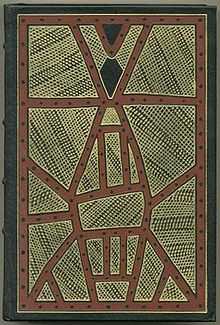The Songlines
 First edition | |
| Author | Bruce Chatwin |
|---|---|
| Country | United Kingdom |
| Language | English |
| Publisher | Franklin Press |
Publication date | 1987[1] |
| Media type | Print (Hardback & Paperback) |
The Songlines is a 1987 book written by Bruce Chatwin, combining fiction and non-fiction. Chatwin describes a trip to Australia which he has taken for the express purpose of researching Aboriginal song and its connections to nomadic travel. Discussions with Australians, many of them Indigenous Australians, yield insights into Outback culture, Aboriginal culture and religion, and the Aboriginal land rights movement.
Synopsis
In the book Chatwin develops his thesis about the primordial nature of Aboriginal song. The writing does not shy away from the actual condition of life for present day indigenous Australians, it does not present the songlines as a new-age fad but from an appreciation of the art and culture of the people for whom they are the keystone of the Real. While the book's first half chronicles the main character's travels through Outback Australia and his various encounters, the second half is dedicated to his musings on the nature of man as nomad and city builder.
Thesis
The basic idea that Chatwin posits is that language started as song, and the aboriginal Dreamtime sings the land into existence. A key concept of aboriginal culture is that the aboriginals and the land are one. By singing the land, the land itself exists; you see the tree, the rock, the path, the land. What are we if not defined by our environment? And in one of the harshest environments on Earth one of our oldest civilizations became literally as one with the country. This central concept then branches out from Aboriginal culture, as Chatwin combines evidence gained there with preconceived ideas on the early evolution of man, and argues that on the African Savannah we were a migratory species, moving solely on foot, hunted by a dominant brute predator in the form of a big cat: hence the spreading of "songlines" across the globe, eventually reaching Australia (Chatwin notes their trajectory generally moves from north-east to south-west) where they are now preserved in the world's oldest living culture.
Reactions
Sometimes defined as a travelogue, the text has been criticised for being masculist, colonialist, simplistic and unreliable as both a source on European Australians and Aboriginal culture. Other critics have praised it, and Chatwin in the book is vehemently opposed to the image of the inferiority of the Aboriginals; others also see the author as a proponent of postmodern writing, challenging traditional forms of linear narrative.
References
See also
- Ethnogeology
- Dreaming (spirituality)
- Native title on Aboriginal land rights